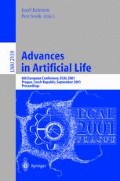Abstract
A Typogenetics is a formal system designed to study origins of life from a “premordial soup” of DNA molecules, enzymes and other building materials. It was introduced by Hofstadter in his book Dialogues with Gödel, Escher, Bach: An Eternal Golden Braid [17]. Autoreplicating molecules and systems of mutually replicating and catalyzing molecules (hypercycles) were modeled in the present paper in a very simplified way. Abstracted molecules in a form of strands are used in a model of a vessel, where “chemical reactions” occur. The approach is very similar to evolutionary algorithms. While a small hypercycle of two molecules mutually supporting their reproduction can be created without extreme difficulties, it is nearly impossible to create a hypercycle involving more than 4 autoreplicators at once. This paper demonstrates, that larger hypercycles can be created by an optimization and inclusion of new molecules into a smaller hypercycle. Such a sequential construction of hypercycles can substantially reduce the combinatorial complexity in comparison with a simultaneous optimization of single components of a large hypercycle.
A part of this work was done by T. Kaláb in the framework of his M.Sc. Thesis at the Institute of Informatics, Fac. of Mathematics, Physics and Informatics, Comenius University, Bratislava, Slovakia.
Access this chapter
Tax calculation will be finalised at checkout
Purchases are for personal use only
Preview
Unable to display preview. Download preview PDF.
References
Adami, C.: Introduction to Artificial Life. Springer-Verlag, New York (1998)
Banzhaf, W.: Self-replicating sequences of binary numbers-I. Foundations, Self-replicating sequences of binary numbers-II. Strings of length N=4. Biological Cybernetics 69 (1993) 269–281
Banzhaf, W.: Self-organization in a system of binary strings. In: Brooks, R., Maes, P. (eds.): Artificial Life IV. MIT Press, Cambridge, MA (1994) 109–119
Banatre, J.-P., Le Metayer, D.: The Gamma Model and its Discipline of Programming. Sci. ofProgr. 15(1990)55–77
Berry, G., Boudol, G.: The Chemical Abstract Machine. Theoret. Comp. Sci. 96 (1992) 217–248
Dittrich, P., Banzhaf, W.: Self-Evolution in a Constructive Binary String System. Artificial Life 4 (1998) 203–220
Dittrich, P.: Artificial Chemistries, a tutorial held at European Conference on Artificial Life, September 13–17, 1999, Lausanne, Switzerland (lecture is available at the address: http://ls11-www.cs.uni-dortmund.de/achem).
Eigen, M.: Self-organization of matter and the evolution of biological macromolecules. Naturwissenschaften 58 (1971) 465–523
Eigen, M., Schuster, P.: The Hypercycle: A Principle of Natural Self-Organization. Springer-Verlag, Berlin (1979).
Farmer, J. D., Kauffman, S. A., Packard, N. H.: Autocatalytic replication of polymers. PhysicaD 22(1982)50–67
Fogel, D. B.: Evolutionary Computation. Towards a New Philosophy of Machine Intelligence. IEEE Press, Piscataway, NJ (1995)
Fontana, W.: Algorithmic chemistry. In: Langton, C. G., Taylor, C., Farmer, J.D., Rasmussen S. (eds.): Artificial Life II. Addison-Wesley, Reading, MA (1992) 159–210
Fontana, W., Schuster, P.: Continuity in evolution. On the nature of transitions. Science 280(1998)1451–1455
Fontana, W., Wagner, G., Buss, L.: Beyond digital naturalism. Artificial Life 1 (1994) 211–227
Goldberg, D. E.: Genetic Algorithms in Search, Optimization, and Machine Learning. Addison-Wesley, Reading, MA (1989)
Haken, H.: Pattern Formation and Pattern Recognition-An Attempt to a Synthesis. In: Haken, H. (ed.): Pattern Formation by Dynamical Systems and Pattern Recognition. Springer Verlag, Heidelberg (1979)
Hofstadter, D.: Dialogues with Gödel, Escher, Bach: An Eternal Golden Braid. Basic Books, Inc, New York (1979) chapters XVI and XVII
Hosokawa, K., Shimoyama, I., Miura, H.: Dynamics of Self-Assembling Systems-Analogy with Chemical Kinetics. In: Brooks, R., Maes, P. (eds.): Artificial Life IV. MIT Press, Cambridge, MA (1994) 172–180
Ikegami, T., Hashimoto, T.: Active mutation in self-reproducing networks of machines and tapes. Artificial Life 2 (1995) 305–318
Kauffman, S. A.: Autocatalytic sets of proteins. Journal of Theoretical Biology 119 (1986) 1–24
Kvasnicka, V., Pospichal, J.: Autoreplicators and Hypercycles in Typogenetics. THEOCHEM (in press). Available at the address http://math.chtf.stuba.sk/pub/vlado/Artificial_Chemistry/Typogenetics_paper_THEO CHEM_final.pdf. An extended version of this paper is available at the address http://math.chtf.stuba.sk/pub/vlado/Artificial_Chemistry/Typogenetics_paper_ECAL_old.pdf
Mitchell, M.: An Introduction to Genetic Algorithms. MIT Press, Cambridge, MA (1996)
Morris, H. C.: Typogenetics: A logic for artificial life. In: Langton, C. G. (ed.): Artificial Life. Addison-Wesley, Reading, MA (1989) 369–395
Pargellis, A. N.: The spontaneous generation of digital “life”. Physica D, 91 (1996) 86–96
Rasmussen, S., Knudsen, C., Feldberg, R., Hindsholm, M.: The Coreworld: emergence and evolution of cooperative structures in a computational chemistry. Physica D 42 (1990) 111–134
Ray, T. S.: An approach to the synthesis of life. In: Langton, C. G., Taylor, C., Farmer, J.D., Rasmussen, S. (eds.): Artificial Life II. Addison-Wesley, Reading, MA (1992) 371–408
Schuster, P.: How does complexity arise in evolution. Complexity 2 (1996) 22–30.
Stadler, P. F., Fontana, W., Miller, J. H.: Random catalytic reaction networks. Physica D 63 (1993) 378–392
Suzuki, Y., Tanaka, H.: Symbolic chemical system based on abstract rewriting and its behavior pattern. Artificial Life and Robotics 1 (1997) 211–219
Varetto, L.: Typogenetics: An artificial genetic system. Journal of Theoretical Biology, 160 (1993) 185–205
Varetto, L.: Studying artificial life with a molecular automaton. Journal of Theoretical Biology 193 (1998) 257–285
Author information
Authors and Affiliations
Editor information
Editors and Affiliations
Rights and permissions
Copyright information
© 2001 Springer-Verlag Berlin Heidelberg
About this paper
Cite this paper
Kvasnička, V., Pospíchal, J., Kaláb, T. (2001). A Study of Replicators and Hypercycles by Typogenetics. In: Kelemen, J., Sosík, P. (eds) Advances in Artificial Life. ECAL 2001. Lecture Notes in Computer Science(), vol 2159. Springer, Berlin, Heidelberg. https://doi.org/10.1007/3-540-44811-X_4
Download citation
DOI: https://doi.org/10.1007/3-540-44811-X_4
Published:
Publisher Name: Springer, Berlin, Heidelberg
Print ISBN: 978-3-540-42567-0
Online ISBN: 978-3-540-44811-2
eBook Packages: Springer Book Archive

